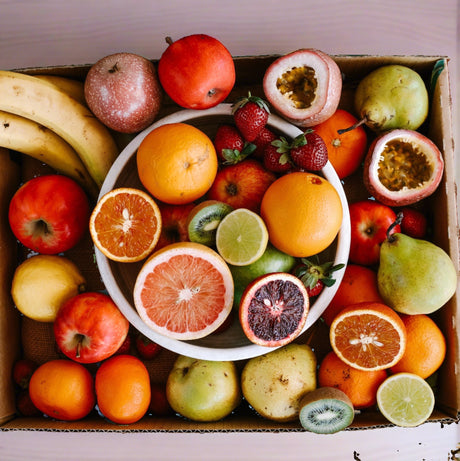
Sometimes to support the health of your family and the health of the planet, we need to take some radical steps. But it doesn’t have to be complicated. It might involve something as simple and easy as signing up for an organic local produce delivery service, like the seasonal boxes we offer at FreshBox, coupled with some small changes around the home. One of the little things we love to do, which encourages our inner gardener and grower, is regrowing food from scraps.
If you haven’t seen this before, it may sound like a strange and messy concept, but the truth is with the right knowledge, regenerative agriculture has never been easier. Of course, you’ll first need to begin with some good quality organic produce, but after that all it takes is a few handy hacks to turn your kitchen into a greenhouse.
Here’s how to grow food from scraps!
Avocado Trees
Gone are the days of choosing between home ownership and your favourite brunch. With this you’ll be smashing avo til your heart’s content.
- Start by cleaning off the pit, removing any remains by rinsing it under cold water and then toweling it dry.
- Push four toothpicks into the pit, evenly spaced apart.
- Use the toothpicks to balance the pit over the top of a glass jar (feel free to salvage a wide-mouthed jar from the recycling bin), making sure the pit is pointy side up. Fill the dish or jar with water, enough that about half of the pit is submerged.
- Place the dish/jar in a sunlit area and change the water every day or so.
- After approximately three to six weeks, the top of the pit will begin to split open. Several weeks after that, a stem, leaves, and roots will begin to grow.
- A few weeks after this growth occurs, you should see leaves. Be patient.
- In approximately three months, when your tree is around 7 to 8 inches tall, plant it in a 10-inch pot with adequate drainage.
- Fill the pot with soil, and press your avocado sapling into it, root-side down (so the top half of the pit remains uncovered).
- Keep the sapling in a sunny area and water it regularly.
Basil Plants
Forget buying basil bunches or dried herbs, these fresh plants can be grown straight from your Veg & Herb Seasonal Box!
- Select several 4-inch stems from a bunch of basil.
- Strip all leaves from about 75 percent of each stem with a sharp knife.
- Put the stems in a jar of water and place in a sunny (but not too hot) location.
- Change the water every other day. You’ll soon notice new roots form along the stems.
- When the roots grow to about 2 inches in length, plant the individual stems in a 4-inch pot.
- Keep the pot in an area that gets at least six hours of sunshine each day, and water regularly.
- Harvest when the plants are full grown but do not remove all the leaves at one time.
Celery Bunches
If you’re a celery juice lover, you need not fear about purchasing bunches and bunches week in and week out. In fact, you can recycle the root and start all over again!
- Rinse off the base of a bunch of celery and place it in a small bowl or similar container (any wide-mouthed, glass, or ceramic container should do).
- Fill the container with warm water, cut stalks facing upright. Place the bowl in a sunny area.
- Leave the base as-is for about one week and change the water every other day. Use a spray bottle to gently mist the plant every other day. The tiny yellow leaves around the center of the base will grow thicker and turn dark green.
- After five to seven days, move the celery base to a planter or garden and cover it with soil, leaving the leaf tips uncovered. Keep the plant well watered.
- You’ll soon notice celery leaves regenerate from the base, as well as a few small stalks. Harvest when fully grown, then repeat the process.
Chilli Peppers
Love spicy food but find yourself forever buying the staple? Chilli peppers are one of the easiest plants to grow from seed.
- Harvest the seeds from your favorite chilli peppers and plant them in a soil-filled pot.
- Place in a sunny area.
- Peppers tend to grow fast, so get your pickling materials ready. Once you have a new crop, save the seeds so you can repeat the process.
Ginger Root
For your staple stirfries and ‘get well soon’ teas, you needn’t look past ginger. And you can even regrow the root yourself.
- Pull off a piece of ginger from a fresh chunk and place it in potting soil with the smallest buds facing down.
- Plant ginger in a garden plot or planter that receives only indirect sunlight. The ginger will grow new shoots and roots.
- When it’s ready to harvest, pull up the entire plant, including the roots. Remove a piece of the rhizome and replant again to continue reaping the rewards.
Lemongrass
Little known fact - lemongrass actually makes a deliciously delightful house plant. Here’s how to regrow it from some that you already have.
- Cut off the tops of a bunch of lemongrass and place the stalks in water.
- Change the water every few days. In approximately two or three weeks, you should see new roots.
- When the stems have developed strong root growth, plant the stalks in a pot or garden (preferably in an area that receives lots of sun). Because lemongrass needs to stay warm year round, plant the stalks in a container that can be moved inside during the winter months.
- Harvest lemongrass once it reaches one foot in height; just cut off the amount you need, being careful not to uproot the plant.
Spring Onions, Leeks & Scallions
Here’s the ultimate starter kit for growing your own at home. Enjoy these simple staples with a little tender loving care.
- Instead of tossing the green part of these veggies, use them to grow more.
- Place the roots and greens in a cup or recycled jar filled with water. Put the cup or jar on a windowsill and change the water every other day.
- In about a week, you should have new greens to add to your supper.
- Harvest when fully grown—just make sure to leave the roots in the water.
Pineapple (The Sunshine Coast Staple)
Would we really be Sunny Coast locals if we didn’t teach you how to grow your own pineapple? Sure it’s a waiting game, but it’s so easy.
- Choose a pineapple with green, fresh leaves.
- Remove the top of the pineapple, ideally by twisting it off (doing so will preserve the parts needed for regrowth).
- Peel back any leaves around the base so the bottom layers are exposed.
- Finally, cut off just the tip of the base, being sure to remove any excess fruit.
- Next, poke three or four toothpicks into the pineapple base right above the area where you peeled back the leaves. Use the toothpicks to suspend the pineapple top over a glass container.
- Add enough water to the container to cover the base of the pineapple top. Leave the whole contraption in a sunny area, change the water every few days, and watch for roots to grow.
- In about a week, roots should begin to form and the green leaves should be longer and wider. When the roots fully form, plant the pineapple top in a planter (or outdoors if you live in a warm climate). Make sure it is exposed to plenty of sunlight, and water it regularly.
- Expect a new pineapple to grow in a few months.
Now that you know how to do it all yourself, do you need some veggies to get you started? Stock up on your favourite fresh, organic and locally grown produce with FreshBox.
























